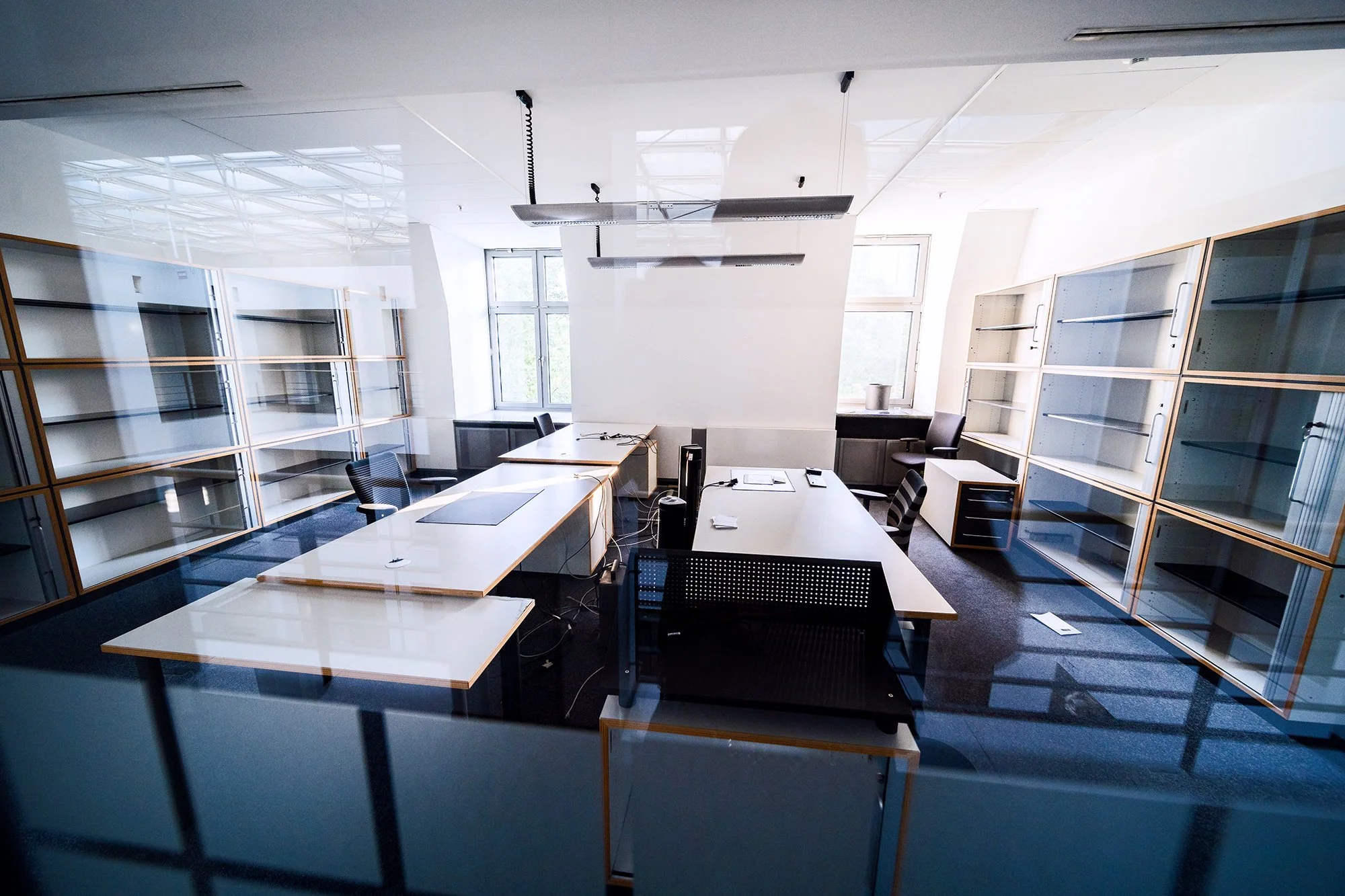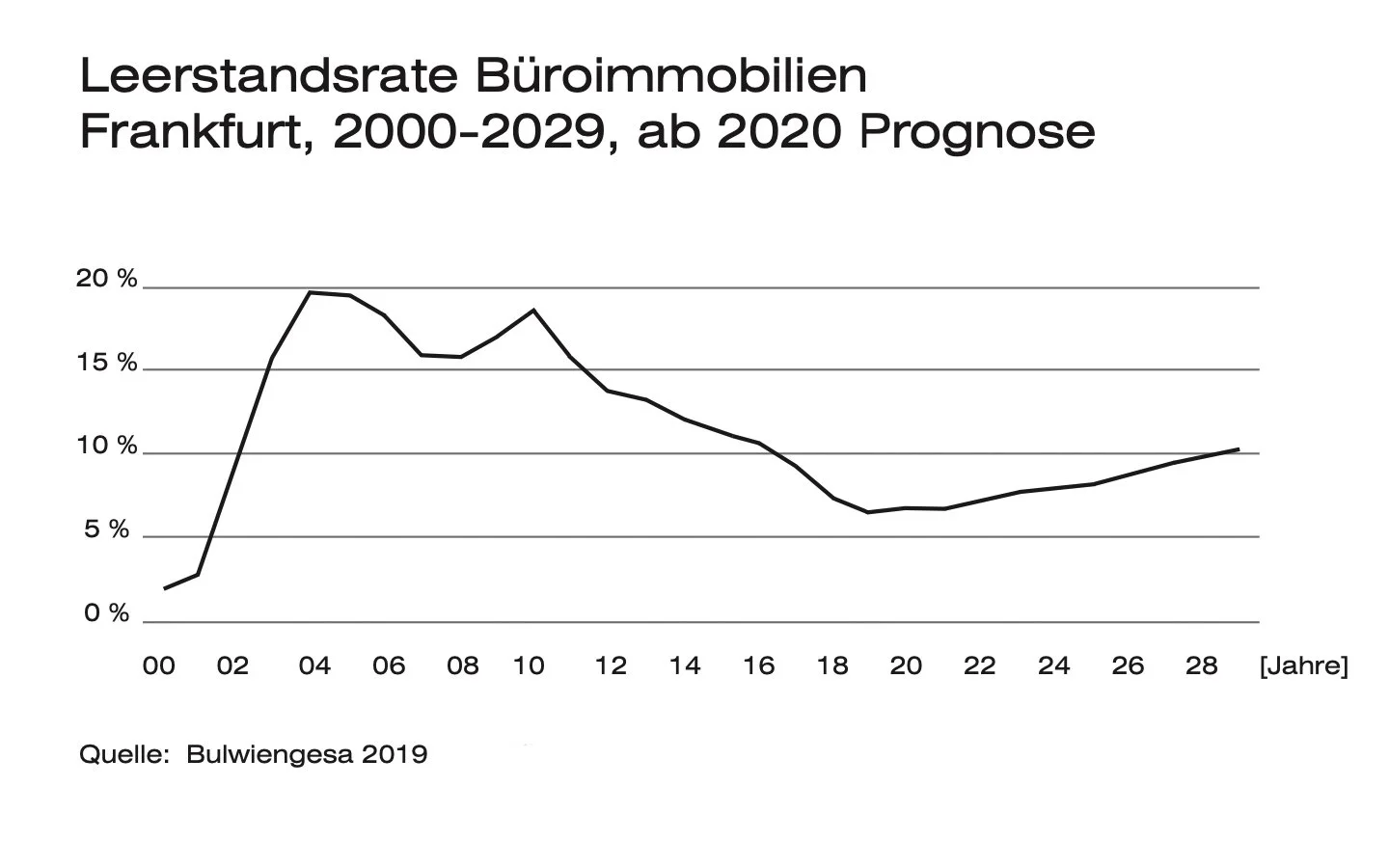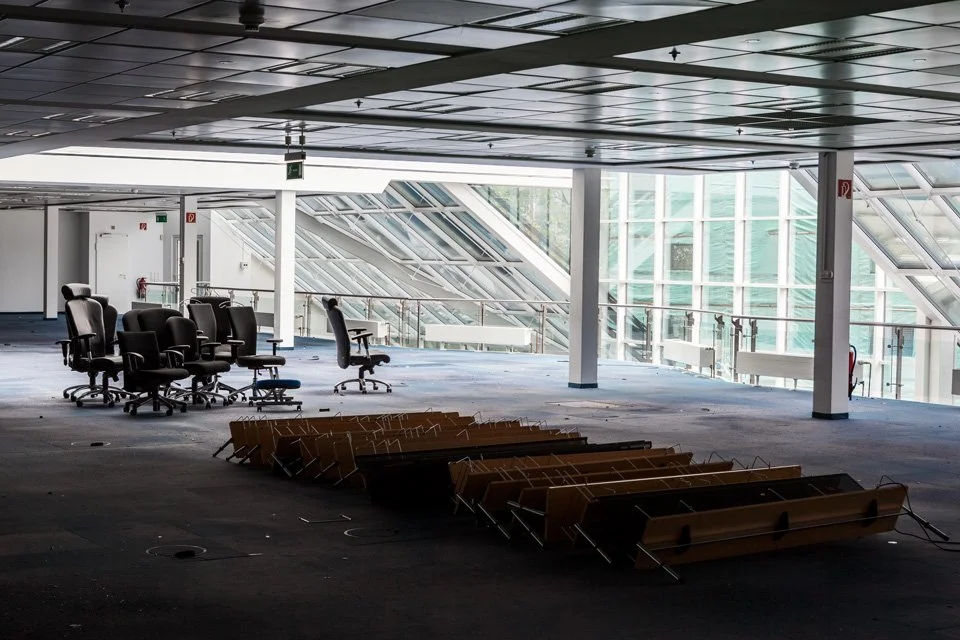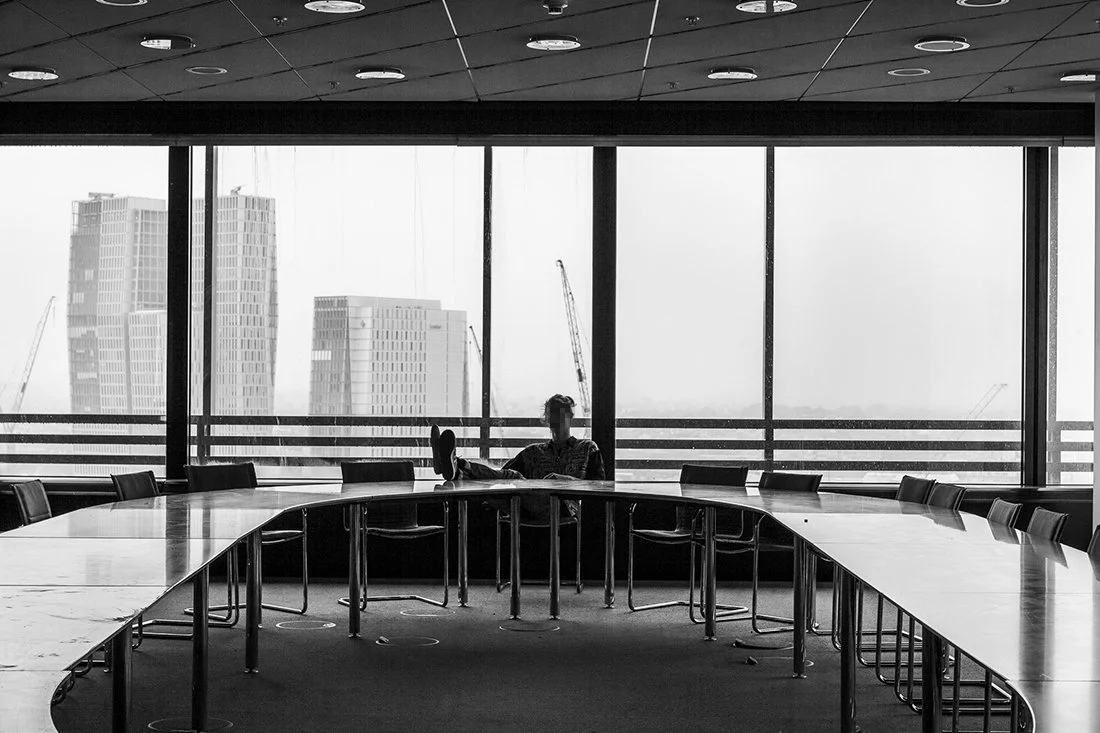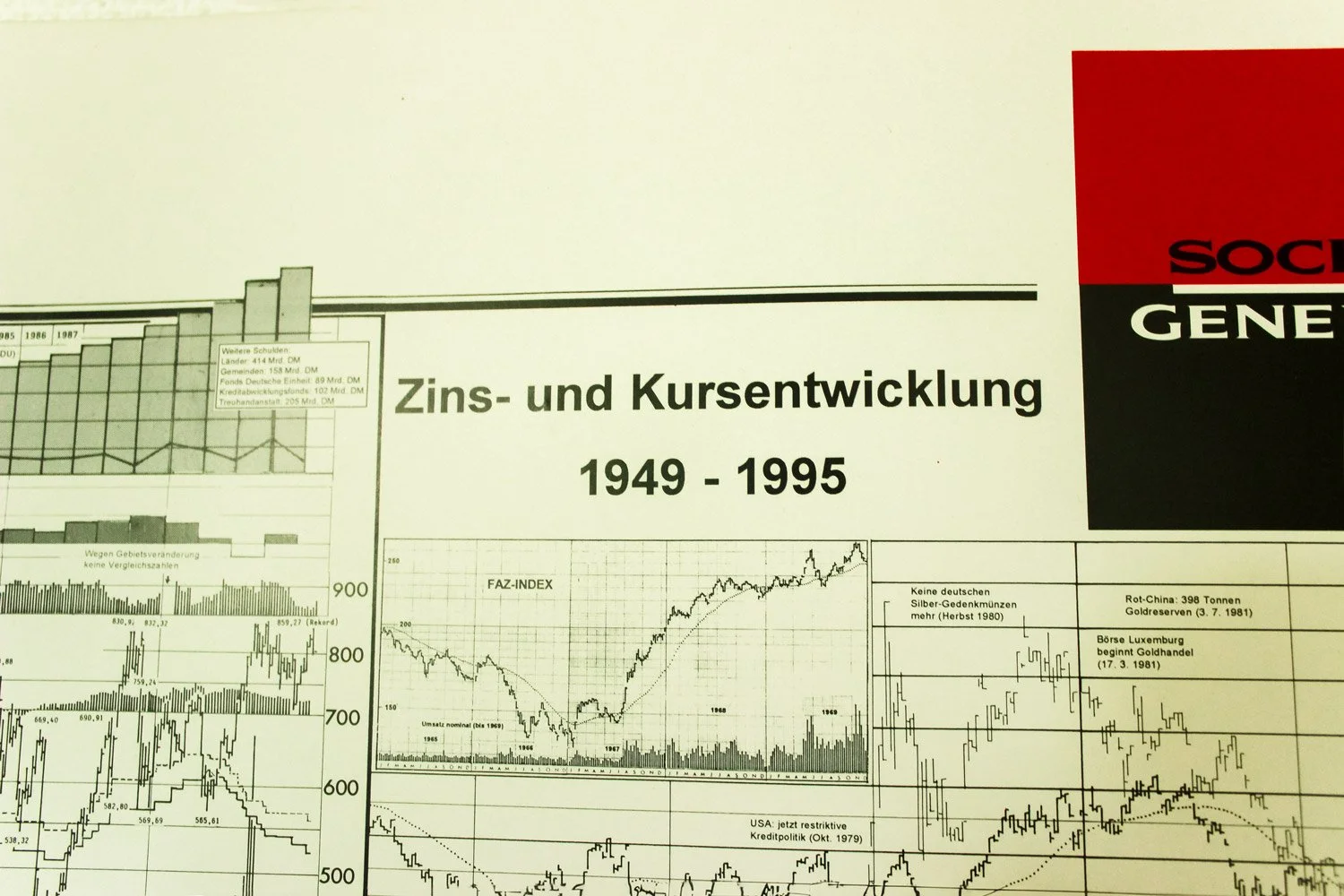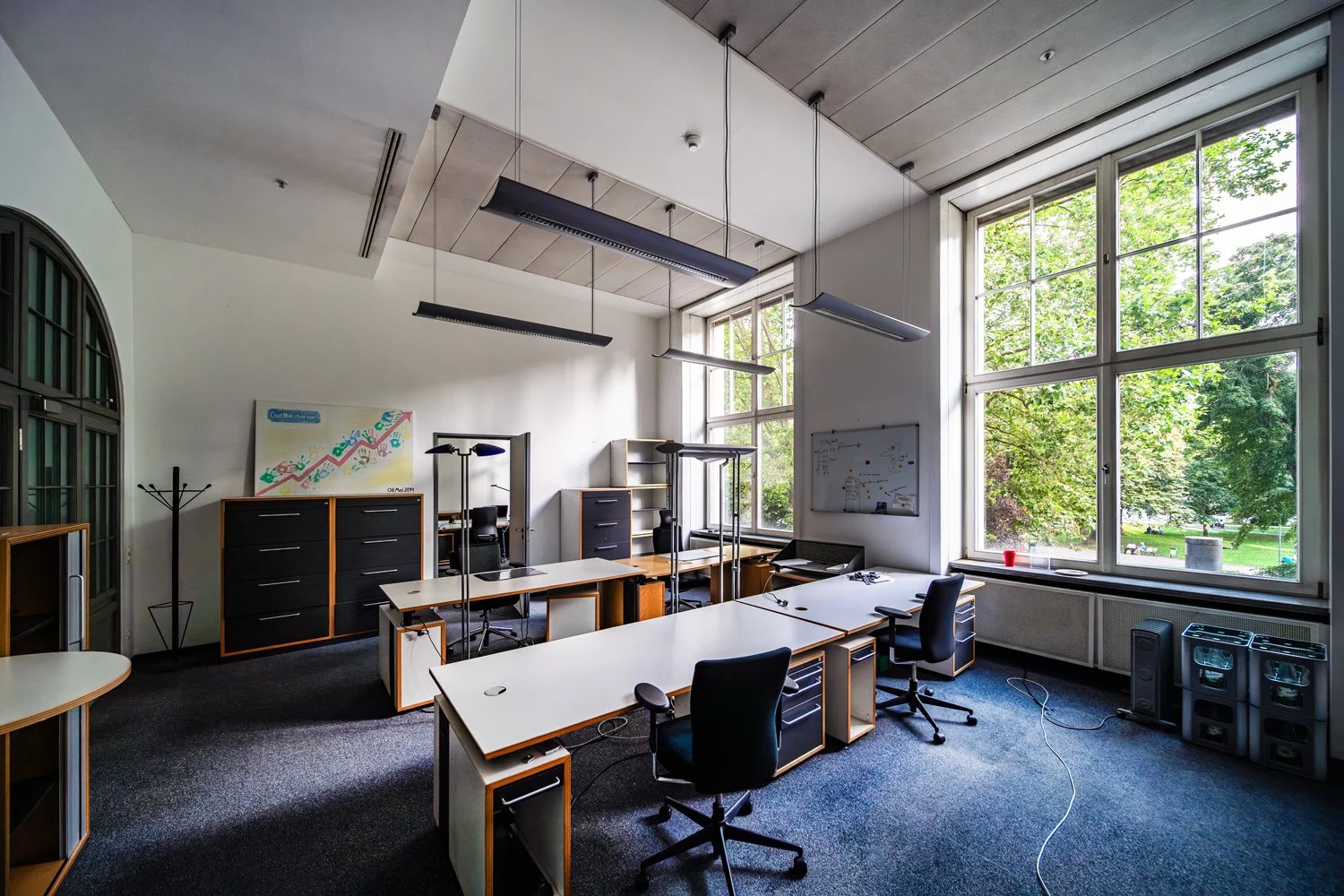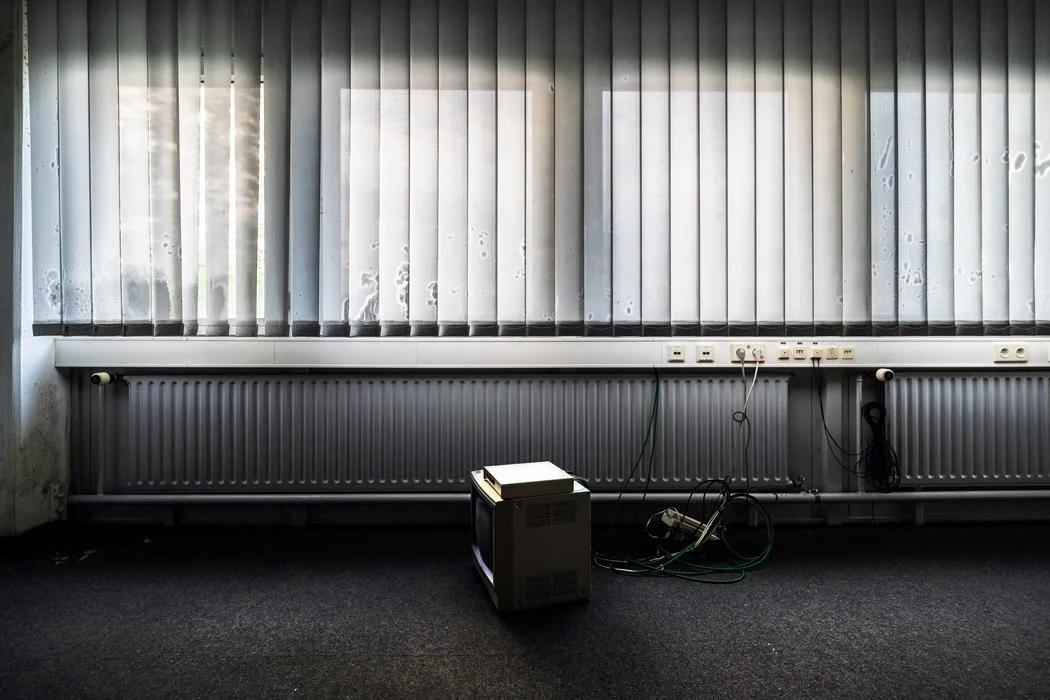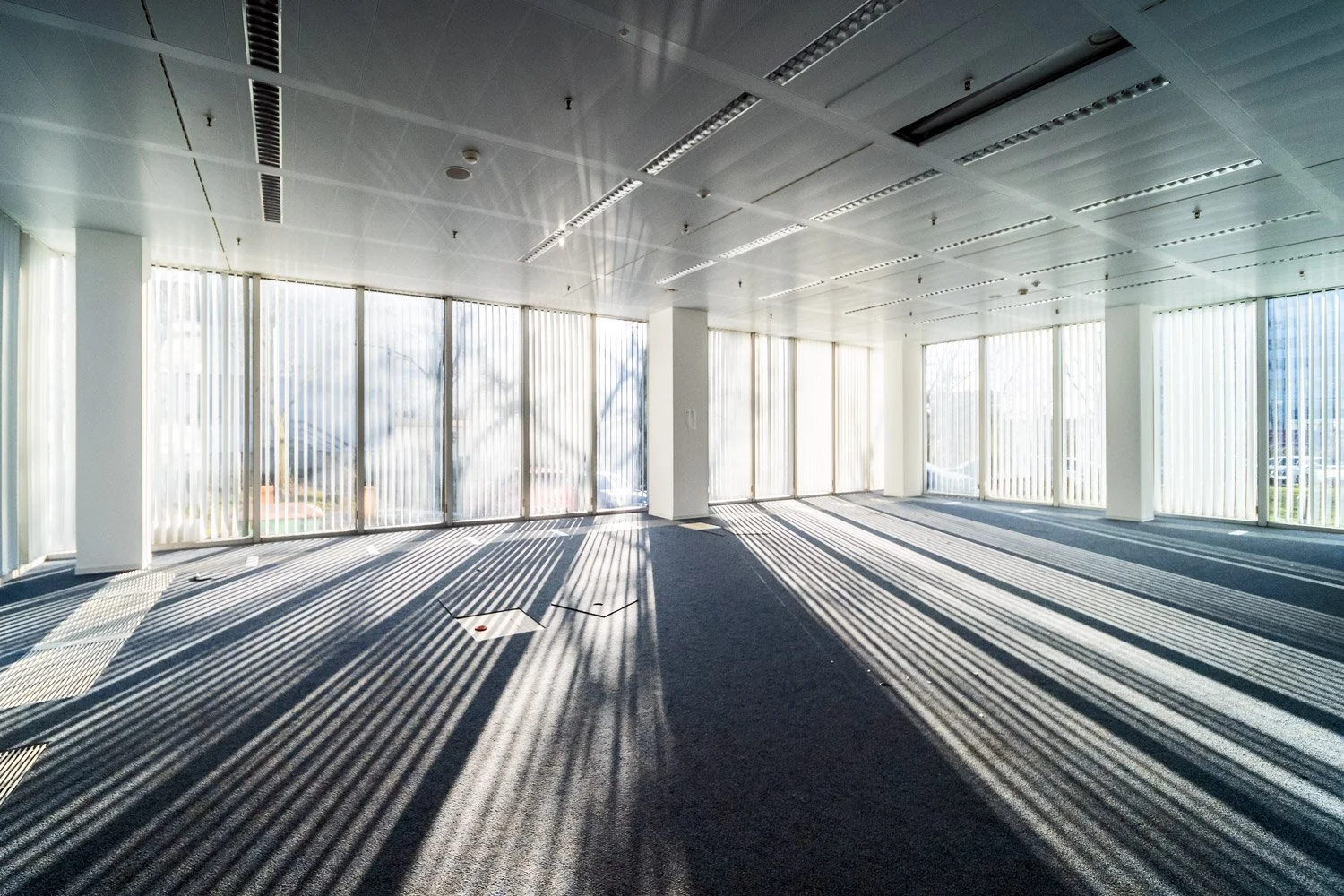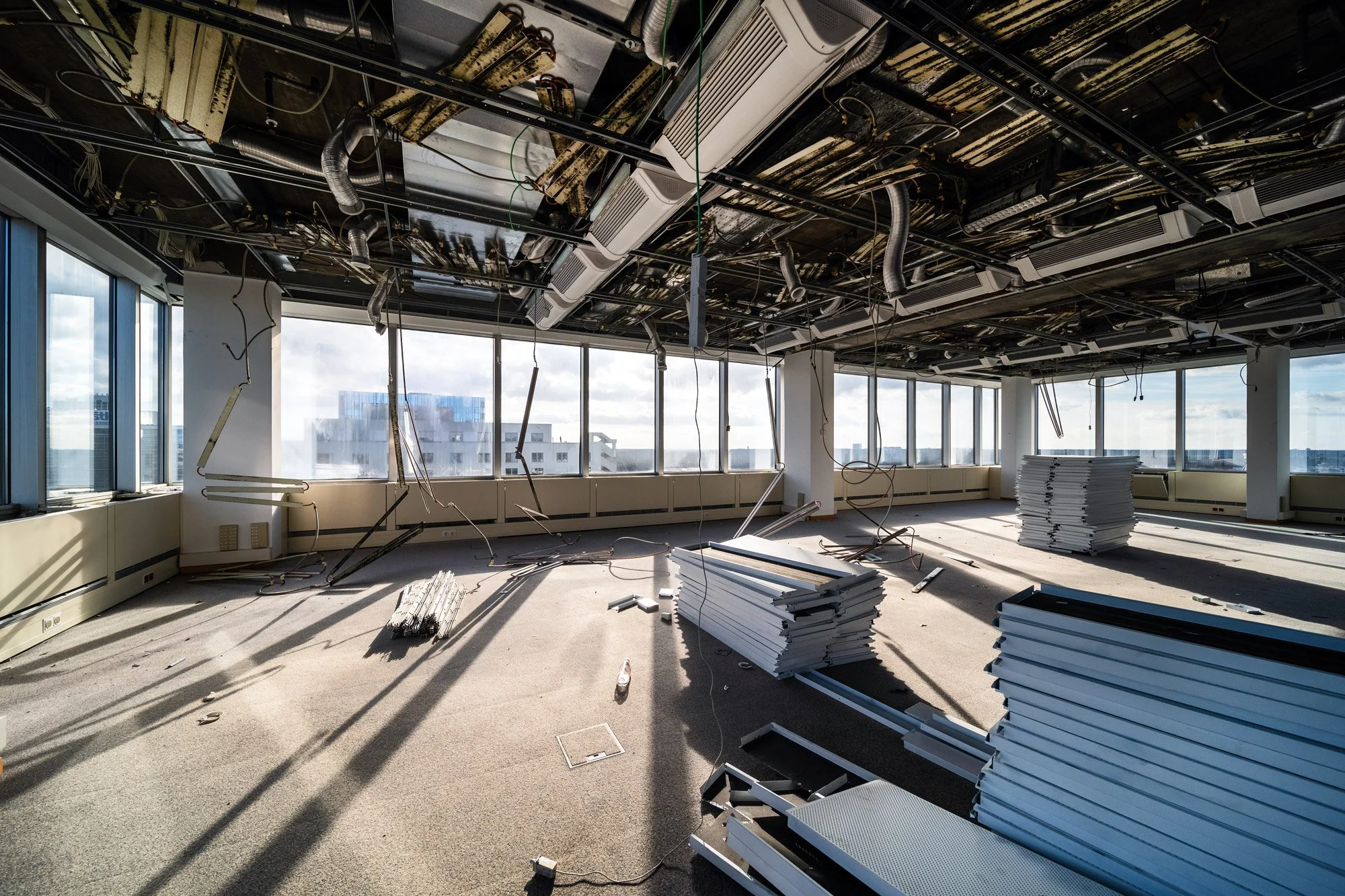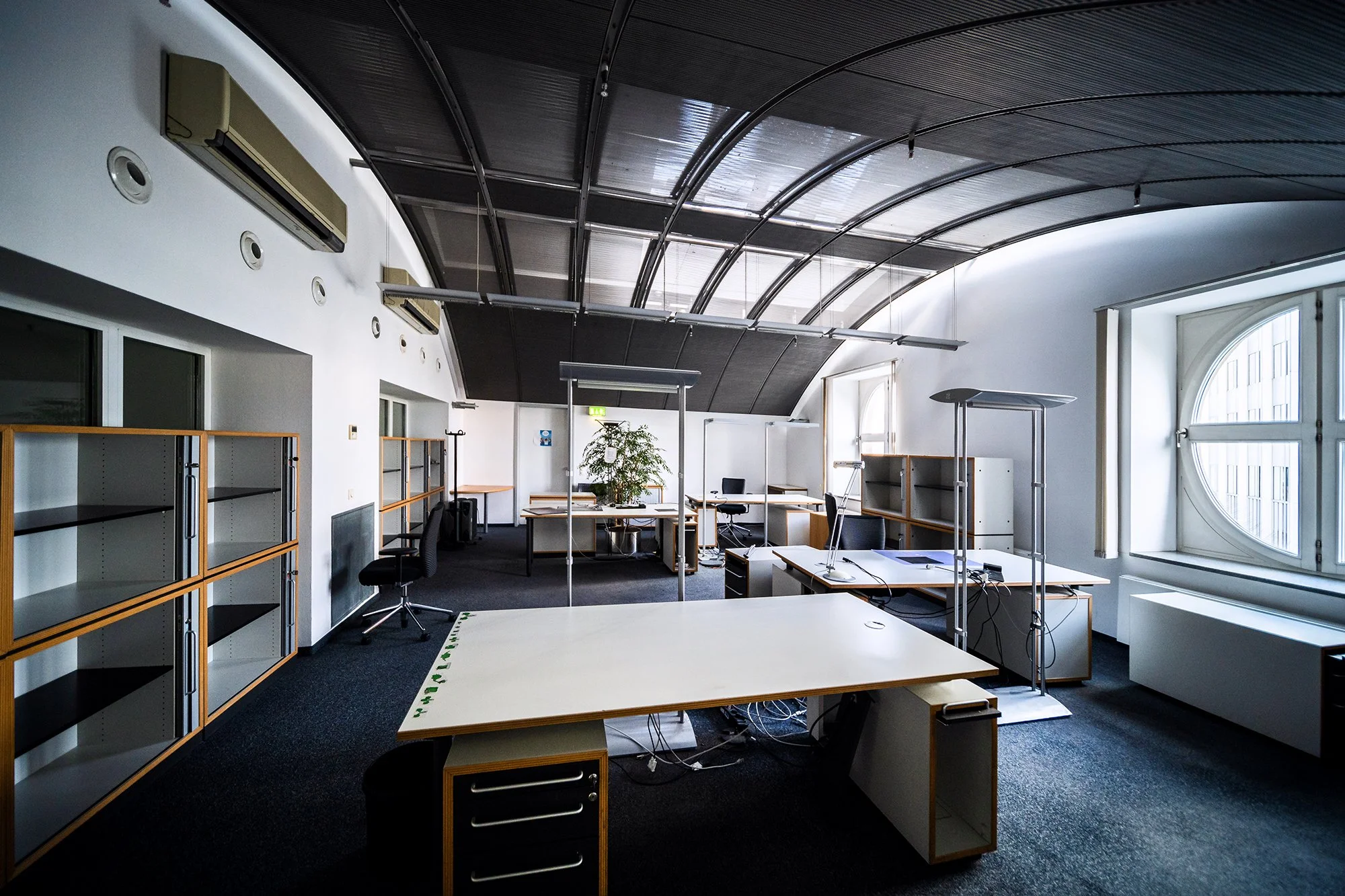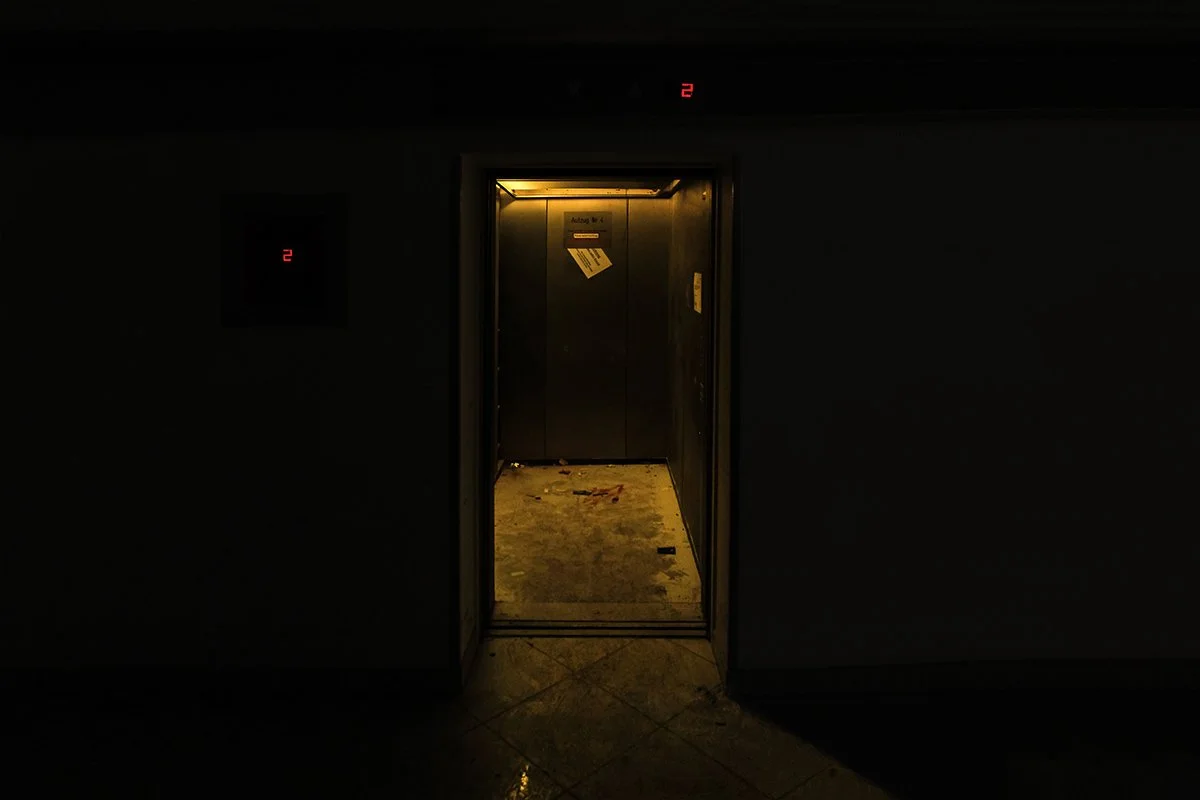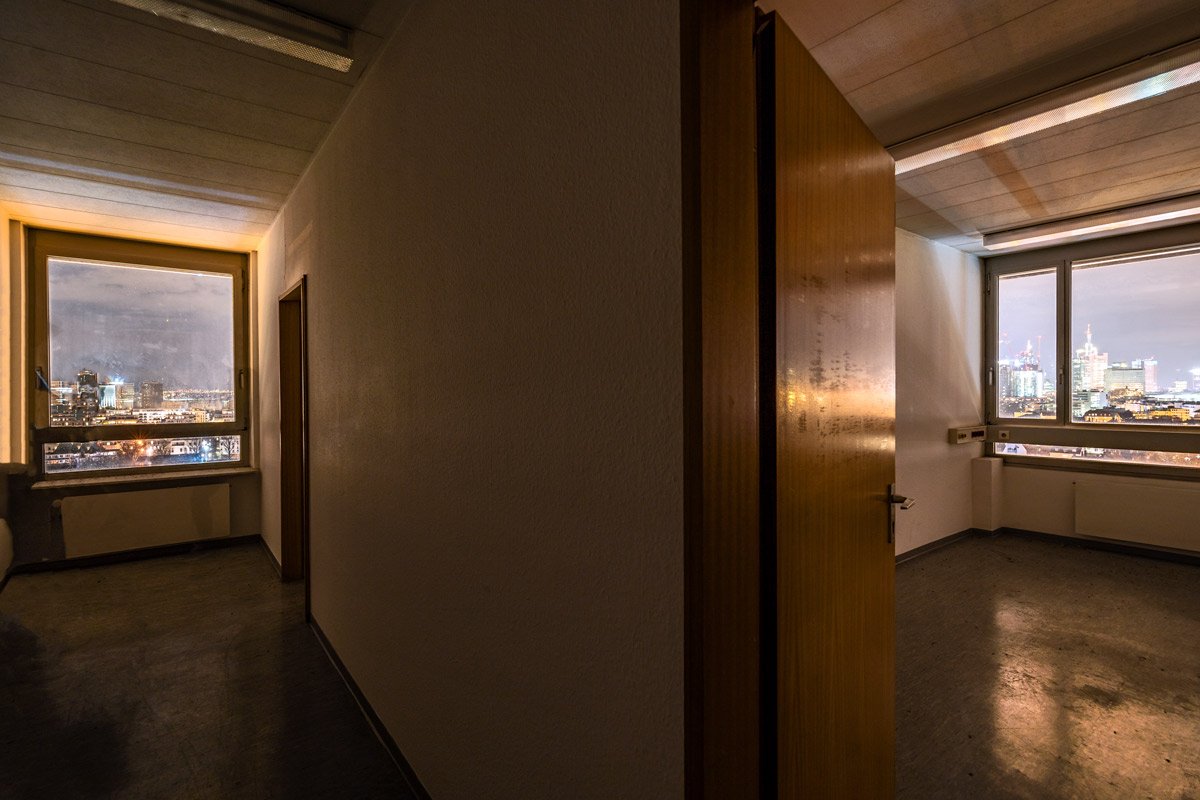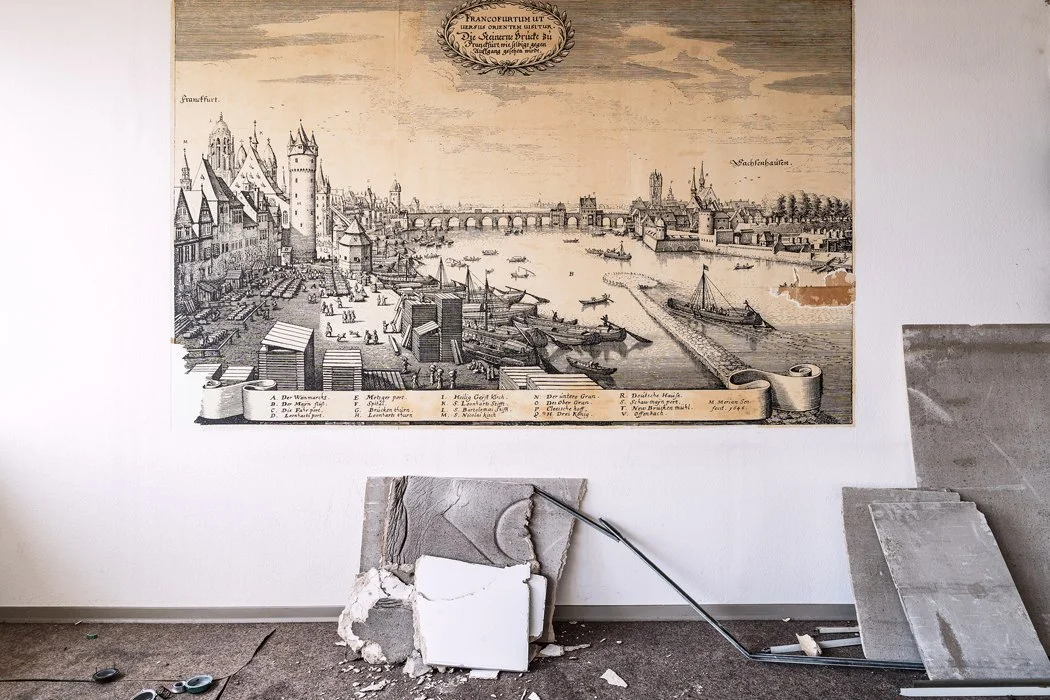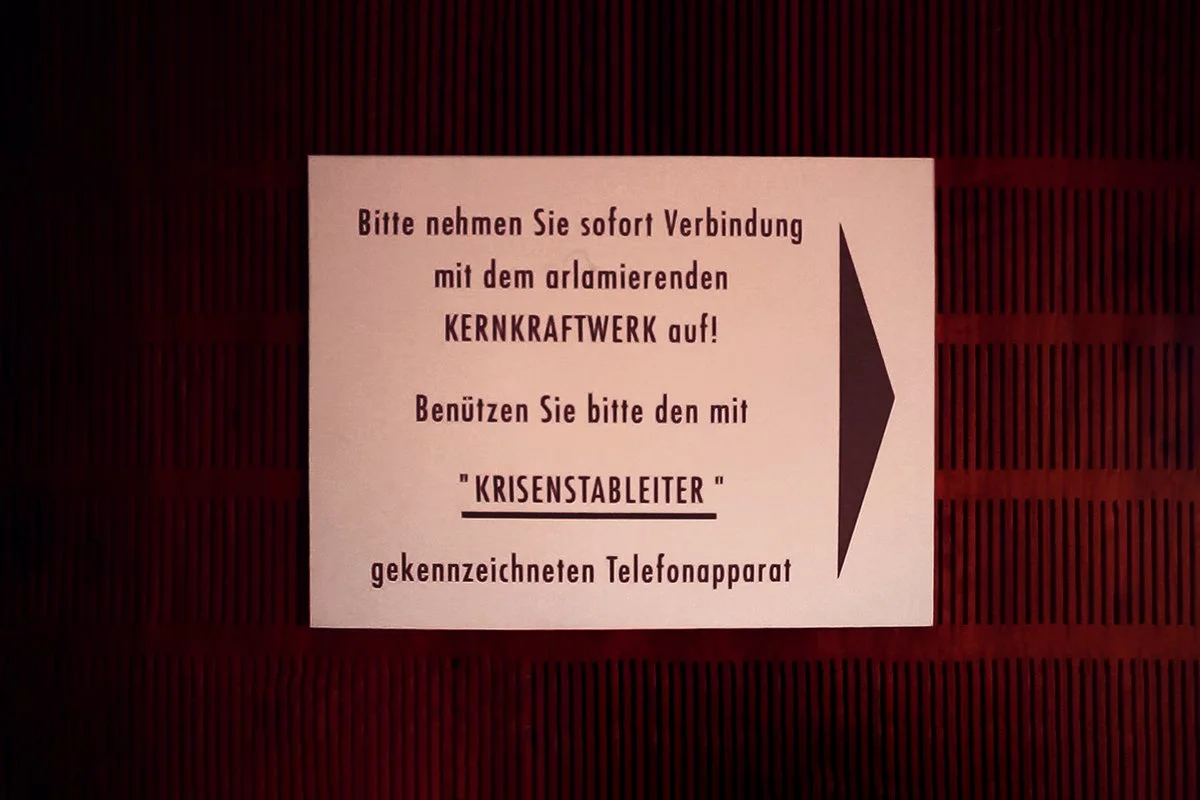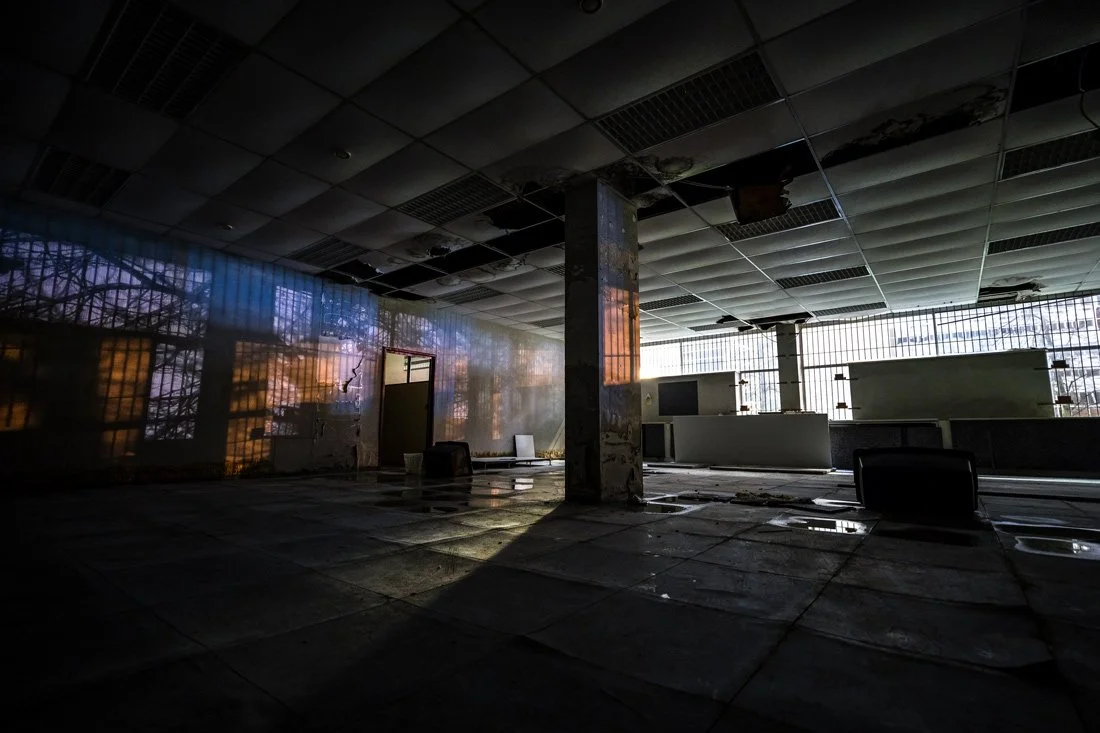Ghost Tower
Dokumentation/Documentary
2016-2021
Von 2016 bis 2021 habe ich Büroleerstand in Frankfurt systematisch dokumentiert. Da ich meine Entdeckungen nicht mit den bekannten Informationen über den aktuellen Zustand des Büroimmobilienmarktes zusammenbringen konnte, habe ich mich dazu entschieden diese Fotoserie weiterzuverfolgen.
Between 2016 and 2021, I systematically documented unoccupied buildings and offices in Frankfurt. What I discovered diverged significantly from the commonly available information about Frankfurt's real estate market, prompting me to create this photo series.
Mainmetropole: Frankfurts Skyline und das Phänomen des urbanen Leerstands | Main Metropolis: Frankfurt’s Skyline and the Phenomenon of Urban Vacancy
Abstract: Frankfurt's skyscrapers are a symbol of a city defined by success and growth. Yet, behind the shiny facades lies another reality: empty offices, forgotten floors, and construction sites that never get completed.
For over 30 years, more and more high-rise buildings have been rising in Frankfurt, accompanied by the seemingly endless noise of new construction projects. The skyline presents the image of a booming financial center, shaped by prestigious banks and strict building regulations. Everything seems focused on efficiency and functionality. Yet, in reality, much of it remains unused. Chaos, vacancy, and decay – things that are seemingly incompatible with the idea of a highly rationalized city – are ever-present when you look closely.
With the photo series “Ghost Tower”, I have been documenting the vacancy in Frankfurt's office landscape for several years. These "ghost towers" represent not only a stark contrast to the ideal image of a meticulously planned city, but also a clear indication of the absurdity of modern urban development.
Synopsis: Frankfurts Hochhäuser sind das Symbol einer Stadt, die sich durch Erfolg und Wachstum definiert. Doch hinter den glänzenden Fassaden lauert eine andere Realität: leere Büros, vergessene Etagen und Baustellen, die nie fertig werden.
Seit über 30 Jahren entstehen in Frankfurt immer mehr Hochhäuser, begleitet vom scheinbar endlosen Lärm neuer Bauprojekte. Die Skyline vermittelt das Bild eines boomenden Finanzzentrums, geprägt von renommierten Banken und strengen Bauvorschriften. Alles scheint auf Effizienz und Funktionalität ausgerichtet. Doch in der Realität bleibt vieles ungenutzt. Chaos, Leerstand und Zerfall – eigentlich unvereinbar mit der Idee einer hoch rationalisierten Stadt – sind allgegenwärtig, wenn man genauer hinschaut.
Mit der Fotoserie “Ghost Tower” dokumentiere ich seit mehreren Jahren den Leerstand in der Frankfurter Bürolandschaft. Diese „Geistertürme“ stehen für mich nicht nur im Kontrast zum Idealbild einer durchgeplanten Stadt, sonder sind klares Indiz der Verrücktheit moderner Stadtentwicklung.
Bei meinen Erkundungen habe ich verschiedene Arten von Leerständen vorgefunden. Eine kurze, vorläufige Typologie basierend auf meinen Beobachtungen und den unterschiedlichen Gründen wird im Folgenden vorgestellt.
Through my explorations, I have identified various types of vacancies, each with different reasons behind them. A concise typology based on my observations is presented below.
Abstract: Frankfurt's skyscrapers are a symbol of a city defined by success and growth. Yet, behind the shiny facades lies another reality: empty offices, forgotten floors, and construction sites that never get completed.
For over 30 years, more and more high-rise buildings have been rising in Frankfurt, accompanied by the seemingly endless noise of new construction projects. The skyline presents the image of a booming financial center, shaped by prestigious banks and strict building regulations. Everything seems focused on efficiency and functionality. Yet, in reality, much of it remains unused. Chaos, vacancy, and decay – things that are seemingly incompatible with the idea of a highly rationalized city – are ever-present when you look closely.
With the photo series “Ghost Tower”, I have been documenting the vacancy in Frankfurt's office landscape for several years. These "ghost towers" represent not only a stark contrast to the ideal image of a meticulously planned city, but also a clear indication of the absurdity of modern urban development.
Spekulativer Leerstand
Reservefläche
Wartend auf Abriss
Übergangsbedingter Leerstand
Modernisierungsbedürftig
Marktaktiver Leerstand
Baustopp
Notwendiges Übel eines Freien Immobilienmarktes
Typologie ausweiten. Tabellarische/Matrixartig Kategorisierung vornehmen:
Zum Beispiel nach Art in marktaktiven und marktinaktiven Leerstand. Baustellen Temporären und Langfristigen Leerstand.
Oder Nach Grund: Mieterwechsel, Rennovierung/Modernisierung, Bankrott, Lieferschwierigkeiten (bei Baustellen, während Corona aufgetreten), Umstrukturierung,
1 Investment Banking Center Frankfurt (IBCF)
Aufnahmedatum: 2018 | Gebäude: IBCF | Standort: Bankenviertel | Baujahr: 1971 | Nutzung: Büro | Aktueller Status: Abriss 2019 | Dauer des Leerstands: 10 Monate | Eigentümer: Deutsche Bank Documented in: 2018 | Building: IBCF | Location: Banking District | Year of construction: 1971 | Use: Office | Current status: Demolished in 2019 | Vacancy duration: 10 months | Owner: Deutsche Bank
2 Der Kraken/Lurgihaus
Aufnahmedatum: 2020 | Gebäude: Lurgihaus | Standort: Mertonviertel | Baujahr: 1987 | Nutzung: Büro | Aktueller Status: Abriss 2021 | Dauer des Leerstands: ≈ 4 Jahre | Eigentümer: Aroundtown SA | Documented in: 2020 | Building: Lurgihaus | Location: Merton District | Year of construction: 1987 | Use: Office | Current status: Demolished in 2020 | Vacancy duration: ≈ 4 years | Owner: Aroundtown SA
3 Kraftwerkunion & Siemens Framatom (KWU)
Aufnahmedatum: 2016 | Gebäude: KWU | Standort: Offenbach-Kaiserlei | Baujahr: 1975 | Nutzung: Büro | Aktueller Status: Entkernung 2017 | Dauer des Leerstands: 16 Jahre | Eigentümer: CG Gruppe | Documented in: 2016 | Building: KWU | Location: Offenbach-Kaiserlei | Year of construction: 1975 | Use: Office | Current status: Gutting completed in 2017 | Vacancy duration: 16 years | Owner: CG Gruppe
3 New Frankfurt Towers, Vitopia Kampus (what’s next?)
Lage: Offenbach-Kaiserlei | Gebäude: KWU | Bau: 1975 | Abriss: (2017 entkernt) | Eigentümer: CG Gruppe | Leerstand: Spekulativer Leerstand | Location: Offenbach-Kaiserlei | Building: KWU | Construction: 1975 | Demolition: (gutting completed in 2017) | Owner: CG Gruppe | Vacancy: Speculative Vacancy
Aufnahmedatum: 2016
3 Neue Mainzer Landstraße 53
Aufnahmedatum: 2915 | Gebäude: Bank | Standort: Innenstadt | Baujahr: 1960 | Nutzung: Büro | Aktueller Status: Abriss 2021 | Dauer des Leerstands: 18 Jahre | Eigentümer: Hessische Landesbank | Documented in: 2015 | Building: Bank | Location: City Center | Year of construction: 1960 | Use: Office | Current status: Demolished in 2021 | Vacancy duration: 18 years | Owner: State Bank of Hesse
4 KWEA (Kreiswehrersatzamt)
Aufnahmedatum: 2020 | Gebäude: KWEA | Standort: Eschborn Süd | Baujahr: 1973 | Nutzung: Militärische Verwaltung | Aktueller Status: Leerstand | Dauer des Leerstands: 15 Jahre + | Eigentümer: Groß & Partner | Documented in: 2020 | Building: KWEA | Location: Eschborn South | Year of construction: 1973 | Use: Military administration office | Current status: Decayed | Vacancy duration: 15 years + | Owner: Groß & Partner
4 Eschersheimer Landstraße 133
Aufnahmedatum: 2017 | Gebäude: Goetha Haus | Standort: Innenstadt | Baujahr: 1987 | Nutzung: Büro | Aktueller Status: X | Dauer des Leerstands: 5 Monate | Eigentümer: Riesa Erste Büro Immobilien GmbH | Documented in: 2017 | Building: Goetha Haus | Location: City Center | Year of construction: 1987 | Use: Office | Current status: Office | Vacancy duration: 5 month | Owner: Riesa Erste Büro Immobilien GmbH
5 Hochhaus am Park
Aufnahmedatum: 2016 | Gebäude: Hochhaus am Park | Standort: Westend-Nord | Baujahr: 1975 | Nutzung: Bü | Aktueller Status: Kernsanierung 2020 | Dauer des Leerstands: ≈ 3 Jahre | Eigentümer: HaP Frankfurt GmbH & Co. KG | Documented in: 2016 | Building: Hochhaus am Park | Location: Westend-North | Year of construction: 1975 | Use: Office | Current status: Core renovation in 2020 | Vacancy duration: ≈ 3 years | Owner: HaP Frankfurt GmbH & Co. KG
6 Commerzbank Wealth Management
Aufnahmedatum: 2022 | Gebäude: Commerzbank Vermögensverwaltung | Standort: Innenstadt | Baujahr: X | Nutzung: Büro | Aktueller Status: Sanierung | Dauer des Leerstands: 11 Monate | Eigentümer: X | Documented in: 2022 | Building: Bank | Location: City Center | Year of construction: X | Use: Office | Current status: Renovation | Vacancy duration: 11 month | Owner: X
7 Frankfurter Sparkasse 1822
Aufnahmedatum: 2021 | Gebäude: Sparkasse 1822 | Standort: Bankenviertel | Baujahr: 1954 | Nutzung: Büro | Aktueller Status: Abriss 2021 | Dauer des Leerstands: 20 Jahre | Eigentümer: Hessische Landesbank | Documented in: X | Building: Sparkasse 1822 | Location: Banking District | Year of construction: 1954 | Use: Office | Current status: Demolished in 2021 | Vacancy duration: 20 years | Owner: State Bank of Hesse
7 City Tower
Aufnahmedatum: 2015 | Gebäude: City Tower | Standort: Mathildenviertel (OF) | Baujahr: 2003 | Nutzung: Büro | Aktueller Status: Leerstand | Dauer des Leerstands: über 22 Jahre mit Unterbrechungen | Eigentümer: Commerz Grundbesitz Investmentgesellschaft mbH (CGI) —> Comer Group Europe | Documented in: 2015 | Building: City Tower | Location: Mathildenviertel (OF) | Year of construction: 2003 | Use: Office | Current status: vacant | Vacancy duration: 10 years + | Owner: Commerz Grundbesitz Investmentgesellschaft mbH (CGI) —> Comer Group Europe
8 Mainzer Landstraße 790
Aufnahmedatum: 2021 | Gebäude: Gemischtes Bürogebäude | Standort: Gallus | Baujahr: 1978 | Nutzung: Büro | Aktueller Status: baufällig | Dauer des Leerstands: 10 Jahre + | Eigentümer: X | Documented in: X | Building: Mixed Office Building | Location: Gallus | Year of construction: 1978 | Use: Office | Current status: No | Vacancy duration: 10 years + | Owner: X
Büroleerstand, ein ganz normales Phänomen? | Office vacancy, just regular phenomenon?
Das Leerstandsverhältnis für Büroflächen gibt den Prozentsatz der vermietbaren Büroflächen an, die ungenutzt sind. Dieser Index berücksichtigt jedoch keine Büroflächen, die aus Gründen wie rechtlichen Auseinandersetzungen, Bauarbeiten, Verfall oder privater Nutzung nicht zur Vermietung stehen.
Im Jahr 2020, während der COVID-19-Pandemie, verzeichnete Frankfurt ein Leerstandsverhältnis von 6,9%. Im Vergleich mit anderen Städten verzeichnete Frankfurt mehr Leerstand als in Hamburg (2,6%), Berlin (1,2%), Köln (2,4%), München (2,2%) und Düsseldorf (5,3%) (1).
In den vergangenen Jahren war das Leerstandsverhältnis in Frankfurt deutlich niedriger. Im Jahr 2000 betrug es 2%. Nach dem Zusammenbruch der dot-com-Blase erreichte es seinen bisherigen Höchstwert von 18%. Seit 2017 steigt er kontinuierlich an. Prognosen sehen einen anhalten Trend, der bis 2029 auf 10% ansteigen wird (2).
Die Gründe für den Anstieg der Leerstände reichen von einer allgemeinen Überversorgung bis hin zu spezifischen lokalen Faktoren und einer Präferenz für Neubauten gegenüber älteren Bestandsgebäuden. Grundlegende strukturelle Veränderungen im Finanzgewerbe, die zu verringerten Personalbestand führen, eine zunehmende Homeofficekultur und das spekulative Verhalten auf dem städtischen Immobilienmarkt, verschärfen die Situation. Dies ist insbesondere in Frankfurt, wo viele Hochhäuser sowohl im Eigentum als auch in der Nutzung durch die gleichen Unternehmen sind, ausgeprägt. Diese unflexible Eigentümerstruktur erschwert es, auf Nachfrageschwankungen zu reagieren.
Zudem tragen Missverhältnisse zwischen den Planungsprozessen privater und öffentlicher Investoren, der Kapazität der Bauindustrie und der tatsächlichen Marktnachfrage zu Ungleichgewichten auf dem urbanen Immobilienmarkt bei. In den letzten zehn Jahren hat Frankfurt einen rasanten Anstieg der Immobilienpreise erlebt. Dieser Trend wurde im Global Real Estate Bubble Index 2021 von UBS hervorgehoben, der das Risiko einer Immobilienblase in Frankfurt höher einstufte als in Toronto, Hongkong oder London (3).
The vacancy ratio for office space represents the percentage of rentable office space that remains unoccupied. This index does not account office spaces unavailable for rent due to reasons such as legal disputes, construction activities, decay, or private use.
In 2020, during the COVID-19 pandemic, Frankfurt recorded a vacancy ratio of 6.9%. Among major German cities, Frankfurt had the highest vacancy ratio, compared to Hamburg (2.6%), Berlin (1.2%), Cologne (2.4%), Munich (2.2%), and Düsseldorf (5.3%) (1).
In previous years the vacancy ratio in Frankfurt was much lower. In 2000, just before the burst of the dot-com bubble, it stood at only 2%. However, it spiked to 18% in the aftermath of the bubble's collapse. Since 2017, office-related vacancies have been on the rise again. A studies predict the continuity of this trend, estimating a vacancy ratio of 10% by 2029 (2).
The reasons for rising vacancies range from general oversupply to specific local factors and a preference for new buildings over older stock. Structural changes in the banking sector, including reduced staffing needs, the rise of remote work, and the increased speculative behaviour on the urban real estate markets, further exacerbate this situation. This is particularly pronounced in Frankfurt, Germany’s financial hub, where many high-rises are both owned and occupied by the same companies. This inflexible ownership structure makes it challenging to adapt to shifts in demand.
Additionally, mismatches between the planning processes of private and public investors, the capacity of the construction industry, and actual market demand contribute to imbalances in the urban real estate market. Over the past decade, Frankfurt has experienced rapid inflation in real estate prices. This trend was highlighted in UBS's 2021 Global Real Estate Bubble Index, which ranked Frankfurt’s bubble risk higher than Toronto, Hong Kong, or London (3).
Ist Leerstand problematisch? | Is vacancy problematic?
Quellen | Sources
(1) Colliers International Deutschland (2020): Bürovermietung und Investment Martkbericht 2020/2021. [https://www.colliers.de/wp- content/uploads/2021/02/Colliers_Research_Marktbericht_Bürovermietung.pdf]
(2) bulwiengesa AG (2019): Büroflächenstudie Frankfurt am Main 2019. [https://stadtplanungsamt-frankfurt.de/show.php?ID=20450&psid=t23pad3oq61jpcuofhsk6l55c1]
(3) UBS Media (2020): UBS Global Real Estate Bubble Index 2020: München und Frankfurt sind die am stärksten überbewerteten Wohnungsmärkte weltweit. [https://www.ubs.com/global/de/media/display-page-ndp/de-20200930-ubs-bubble-index-2020.html]




